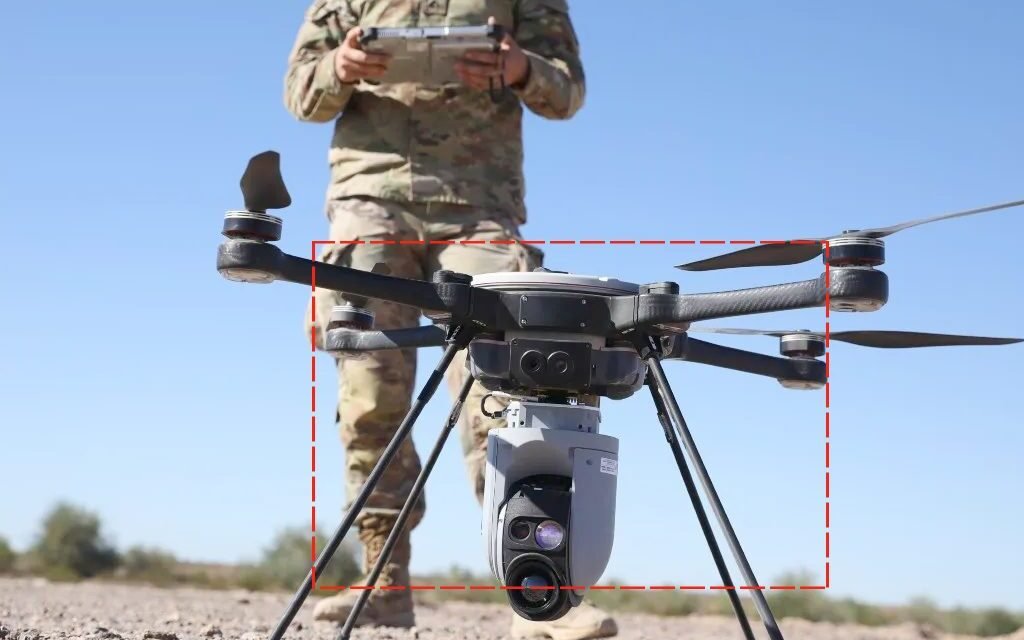Anti-drone systems play a crucial role in protecting military installations and personnel by detecting, identifying, and neutralizing hostile drones. These systems address threats posed by drones, including surveillance, delivery of explosive payloads, electronic interference, and swarm attacks. Here’s how anti-drone systems protect military assets:
1. Early Detection and Identification
- Radar Systems:
- Detect and track drones at various ranges and altitudes, even those with small radar cross-sections.
- Example: 3D radars provide precise location and movement tracking of drones.
- Electro-Optical and Infrared (EO/IR) Sensors:
- Enhance detection in low-light or complex environments by identifying drones based on heat signatures or visual characteristics.
- Acoustic Sensors:
- Recognize the unique sound signatures of drone propellers, useful in urban or cluttered environments.
- Radio Frequency (RF) Scanning:
- Monitors RF signals to detect and classify drones operating on known communication frequencies.
2. Threat Assessment and Identification
- AI and Machine Learning:
- Analyze sensor data to differentiate between drones and other objects (e.g., birds or aircraft), reducing false alarms.
- Identify drone types, flight patterns, and potential threats based on historical data and real-time analysis.
- Visual Identification:
- High-resolution cameras enable manual or automated visual confirmation of potential drone threats.
3. Neutralization and Mitigation
- Electronic Countermeasures (ECM):
- Jamming:
- Disrupts communication between the drone and its operator, causing the drone to lose control or return to its launch point.
- Spoofing:
- Sends false GPS or control signals to misdirect the drone or force it to land.
- RF Hacking:
- Takes control of the drone by overriding its command systems.
- Jamming:
- Kinetic Countermeasures:
- Projectile-Based Systems:
- Use traditional weaponry, such as anti-aircraft guns, to shoot down drones.
- Example: Advanced airburst munitions optimized for small, fast-moving targets.
- Missile Systems:
- High-precision missiles can engage drones at long distances.
- Laser Weapons:
- Directed energy weapons (DEWs) disable drones by burning critical components or sensors.
- Projectile-Based Systems:
- Physical Capture:
- Net Guns:
- Fire nets to entangle and neutralize drones mid-flight.
- Interceptor Drones:
- Specialized drones equipped with nets or kinetic tools to capture or destroy hostile drones.
- Net Guns:
4. Protection Against Swarm Attacks
- AI-Driven Countermeasures:
- Coordinate multiple anti-drone systems to track and neutralize drone swarms efficiently.
- Directed Energy Weapons (DEWs):
- High-energy lasers or microwaves can engage multiple drones in rapid succession, ideal for swarm scenarios.
- Drone Swarm Countermeasures:
- Deploy interceptor drone swarms or high-powered jamming systems to neutralize multiple drones simultaneously.
5. Multi-Layered Defense Systems
- Perimeter Defense:
- Deploy sensors and countermeasures around the installation to detect and neutralize drones before they breach critical areas.
- Zonal Protection:
- Create layered zones with increasing levels of defense to protect high-value assets.
- Integration with Air Defense Systems:
- Anti-drone systems are integrated with broader air defense networks for seamless protection against various aerial threats.
6. Protecting Personnel
- Force Protection:
- Neutralize drones delivering explosive payloads or conducting reconnaissance on troop movements.
- Escort and Convoy Security:
- Deploy portable anti-drone systems to protect convoys and personnel in transit.
- Detection of Surveillance Threats:
- Prevent drones from gathering intelligence on troop positions or activities.
7. Portability and Rapid Deployment
- Man-Portable Systems:
- Lightweight, handheld anti-drone devices allow soldiers to counter drone threats in the field.
- Example: Devices like DroneDefender use RF jamming for quick neutralization.
- Vehicle-Mounted Systems:
- Anti-drone systems mounted on military vehicles provide mobility and protection for moving units.
- Fixed and Deployable Systems:
- Stationary systems protect bases and installations, while rapidly deployable systems safeguard temporary outposts.
8. Countering Emerging Drone Threats
- Autonomous Drones:
- Anti-drone systems are designed to detect and neutralize drones operating without active communication links (autonomous modes).
- Miniature and Nano Drones:
- Advanced sensors and AI detect smaller drones that evade traditional radar systems.
- Loitering Munitions:
- Anti-drone measures intercept drones designed for kamikaze-style attacks on critical assets.
9. Integration with Military Networks
- Network-Centric Warfare:
- Anti-drone systems share real-time threat data with other defense systems, enabling coordinated responses.
- AI-Powered Decision-Making:
- Automated responses optimize the engagement of threats based on priority and risk level.
10. Training and Simulation
- Operator Training:
- Personnel are trained to use anti-drone systems effectively, improving readiness.
- Simulated Drone Threats:
- Simulations prepare troops and systems to counter diverse drone scenarios.
Examples of Anti-Drone Systems
- Israel’s Drone Dome:
- Combines radar, electro-optical sensors, and lasers for effective detection and neutralization.
- SkyWall 100:
- A handheld system that captures drones using nets.
- Raytheon’s Coyote:
- Interceptor drones designed to counter enemy UAVs.
- US Army’s Mobile Expeditionary High-Energy Laser (MEHEL):
- A vehicle-mounted laser system for targeting drones.
Strategic Advantages
- Enhanced Security:
- Protects critical installations, high-value assets, and personnel from surveillance and attacks.
- Cost-Effectiveness:
- Neutralizes drones, which are relatively low-cost threats, with efficient and scalable countermeasures.
- Force Multiplication:
- Increases the effectiveness of existing defense systems by addressing an emerging category of threats.
In conclusion, anti-drone systems are essential for modern military operations, offering robust protection against the growing threats posed by drones. By integrating advanced detection, identification, and neutralization technologies, these systems safeguard installations, personnel, and critical assets in an increasingly drone-dependent battlefield.
Hashtags
#AntiDroneTech #DroneDefense #CounterUAVSystems #AntiDroneTechnology #DroneThreatProtection #MilitaryApplications #MilitaryDroneDefense #BaseProtectionTech #AntiDroneDefense #MilitaryPersonnelSafety #DroneCountermeasures #DroneDetection #NeutralizingThreats #AdvancedSurveillanceTech #DroneInterception #ThreatNeutralization













